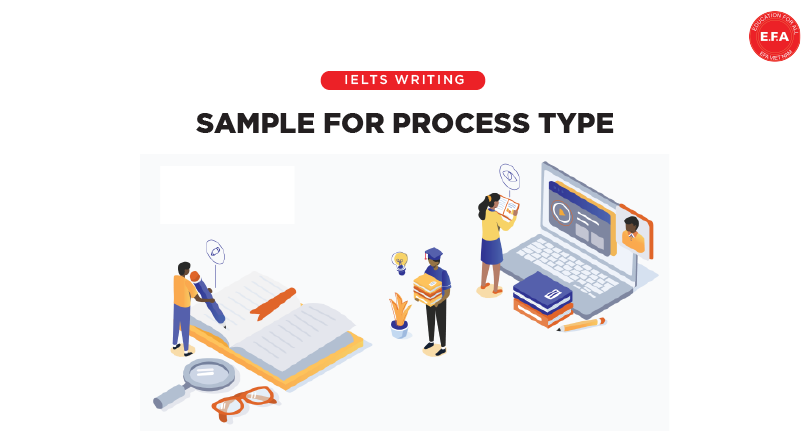Như chúng ta đều biết rằng trong IELTS Writing Task 1 sẽ có 7 dạng bài chính bao gồm: Line graphs, Pie charts, Bar charts, Table, Process, Maps, Multiple charts. Trong bài viết này, EFA Việt Nam sẽ giới thiệu đến các bạn những bài viết tham khảo về cách viết dạng bài “Process” trong IELTS Writing Task 1.

Nội dung bài viết
1. Process diagram.
Process diagrams show how something is done or made. They always show steps/stages. Here’s some advice about how to describe them:
- Try to write 4 paragraphs – introduction, summary of main points, 2 detail paragraphs.
- Write the introduction by paraphrasing the question (rewrite it by changing some of the words).
- For your summary, first say how many steps there are in the process. Then say where/how the process begins and ends (look at the first and last stages).
- In paragraphs 3 and 4, describe the process step by step. Include the first and last steps that you mentioned in the summary, but try to describe them in more detail or in a different way.
- You could describe the steps in one paragraph, but it looks more organised if you break the description into two paragraphs. Just start paragraph 4 somewhere in the middle of the process.
- Mention every stage in the process.
- Use ‘sequencing’ language e.g. at the first / second / following / final stage of the process, next, after that, then, finally etc.
- Times (e.g. past dates) are not usually shown, so use the present simple tense.
- It’s usually a good idea to use the passive e.g. ‘At the final stage, the product is delivered to shops’ (because we don’t need to know who delivered the product).
2. Forecast in Australia.
The diagram below shows how the Australian Bureau of Meteorology collects up- to-the-minute information on the weather in order to produce reliable forecasts.
The figure illustrates the process used by the Australian Bureau of Meteorology to forecast the weather.
There are four stages in the process, beginning with the collection of information about the weather. This information is then analysed, prepared for presentation, and finally broadcast to the public.
Looking at the first and second stages of the process, there are three ways of collecting weather data and three ways of analysing it. Firstly, incoming information can be received by satellite and presented for analysis as a satellite photo. The same data can also be passed to a
radar station and presented on a radar screen or synoptic chart. Secondly, incoming information may be collected directly by radar and analysed on a radar screen or synoptic chart. Finally, drifting buoys also receive data which can be shown on a synoptic chart.
At the third stage of the process, the weather broadcast is prepared on computers. Finally, it is delivered to the public on television, on the radio, or as a recorded telephone announcement.
3. Brick manufacturing.
Here are my 2 main paragraphs describing the steps:
At the beginning of the process, clay is dug from the ground. The clay is put through a metal grid, and it passes onto a roller where it is mixed with sand and water. After that, the clay can be shaped into bricks in two ways: either it is put in a mould, or a wire cutter is used.
At the fourth stage in the process, the clay bricks are placed in a drying oven for one to two days. Next, the bricks are heated in a kiln at a moderate temperature (200 – 900 degrees Celsius) and then at a high temperature (up to 1300 degrees), before spending two to three days in a cooling chamber. Finally, the finished bricks are packaged and delivered.
4. Water cycle.
The diagram below shows the water cycle, which is the continuous movement of water on, above and below the surface of the Earth.
The picture illustrates the way in which water passes from ocean to air to land during the natural process known as the water cycle.
Three main stages are shown on the diagram. Ocean water evaporates, falls as rain, and eventually runs back into the oceans again.
Beginning at the evaporation stage, we can see that 80% of water vapour in the air comes from the oceans. Heat from the sun causes water to evaporate, and water vapour condenses to form clouds. At the second stage, labelled ‘precipitation’ on the diagram, water falls as rain or snow.
At the third stage in the cycle, rainwater may take various paths. Some of it may fall into lakes or return to the oceans via ‘surface runoff’. Otherwise, rainwater may filter through the ground, reaching the impervious layer of the earth. Salt water intrusion is shown to take place just before groundwater passes into the oceans to complete the cycle.
Xem thêm: IELTS Reading Tip: Phương pháp xử lý dạng bài T/F/NG.
IELTS Vocabulary: Những từ vựng hay về chủ đề Physical Appearance
Đó là những mẫu dạng bài trong IELTS Writing Task 1 phần Process các bạn có thể tham khảo và vận dụng trong quá trình ôn thi IELTS. EFA Việt Nam chúc các bạn thành công và đạt được điểm số mong muốn trong kì thi IELTS của mình.
